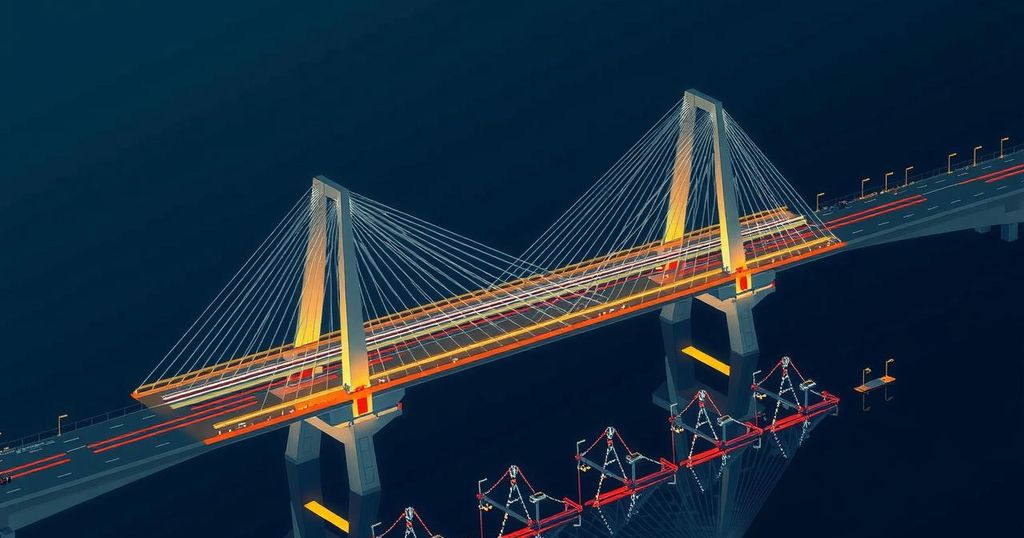Revolutionizing Bridge Safety: The Role of Artificial Intelligence in Predictive Maintenance
Artificial intelligence is revolutionizing bridge health assessments by enhancing predictive maintenance strategies. It processes extensive data to identify potential risks, enabling proactive maintenance decisions. Traditional inspection methods are complemented by advanced AI techniques, such as computer vision and sensor integration, which bolster both safety and efficiency in managing bridge infrastructures.
In recent years, the fusion of artificial intelligence (AI) with predictive maintenance has revolutionized the assessment of bridge health. Through the power of machine learning and sophisticated algorithms, AI breathes life into vast, craggy datasets drawn from structural monitoring systems, effectively enhancing risk evaluations and optimizing both safety and cost-efficiency.
No longer are bridge inspections mere routine exercises; they now embrace intricate technologies that can swiftly analyze images and sensor data to unveil hidden anomalies. Traditional visual inspections, often fraught with human error, now find their match in AI’s unwavering accuracy—detecting even the minutest of structural defects with remarkable precision.
Dynamic structural monitoring underpins AI’s role in bridge management, allowing for the seamless analysis of data collected from embedded sensors. As these sensors gather continuous streams of information, AI alerts engineers to imminent signs of deterioration, paving the way for timely interventions that can extend the life of bridges. This proactive methodology redefines maintenance from a reactionary task to an anticipatory strategy.
Central to AI’s prowess is data integration, which synthesizes various inputs into a cohesive framework, enabling predictive models to forecast both maintenance needs and future conditions with uncanny accuracy. By employing computer vision techniques that mimic human sight yet surpass it, AI systems identify surface anomalies and structural concerns with technical finesse, thus transforming bridge assessment into an art form of machine interpretation.
In the realm of sensor data, the amalgamation of diverse technologies creates a robust narrative of a bridge’s health. Real-time information regarding stress and displacement becomes the script that guides maintenance efforts; algorithms continuously scan this data for danger signs, echoing the bridge’s needs and sparking preemptive action before issues arise. This shift from a reactive to a proactive stance not only conserves resources but significantly bolsters bridge safety.
Predictive deterioration modeling encapsulates AI’s ability to foresee damage progression—melding historical data with current sensor outputs to unveil the future of a structure’s integrity. This foresight not only aids engineers in planning but nurtures a culture of data-driven decision-making, ensuring that each maintenance strategy is nuanced and specific to the bridge in question.
Real-world applications of AI in bridge health management demonstrate the technology’s capabilities. The Oresund Bridge, a marvel connecting Denmark and Sweden, employs AI systems to conduct continuous evaluations, identifying maintenance priorities with precision. In contrast, the Hong Kong-Zhuhai-Macau Bridge showcases the fast-paced inspection capabilities of AI-powered drones that autonomously survey structures, decreasing downtime while increasing accuracy.
To harness the full potential of AI, future research must focus on integrating innovative technologies like the Internet of Things (IoT) and edge computing into bridge management. There is a pressing need for standardized methodologies that apply uniform protocols across various systems, laying the groundwork for an infrastructure that stands resilient against time and nature’s whims.
Steel beams and concrete pillars may form the physical body of bridges, yet it is through the heartbeat of AI that these structures attain their true vitality. By forecasting challenges and reinforcing resilience, AI not only protects the bridges of today but also ensures a safe passage for generations to come.
The integration of artificial intelligence (AI) into the assessment and maintenance of bridges represents a significant leap forward in structural engineering. This technology enhances the predictive capability of existing maintenance strategies, transforming them from reactive to proactive measures. With the capability to analyze massive amounts of data from sensors and visual inputs, AI enriches risk assessments, elevating safety and efficiency in bridge management while simultaneously extending the lifespan of these essential infrastructures.
AI stands at the forefront of a new era in bridge health management, enabling precise assessments and informing proactive maintenance strategies. By embracing technologies such as machine learning, computer vision, and advanced sensor integration, bridge assessments are transformed, ensuring safety, optimizing resource use, and prolonging infrastructure life. As research pivots toward standardization and technological integration, the future promises an even more resilient approach to maintaining our critical infrastructures, protecting not only the bridges but the lives that depend on them.
Original Source: www.pbctoday.co.uk




Post Comment